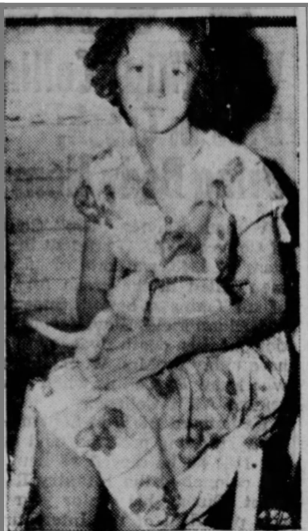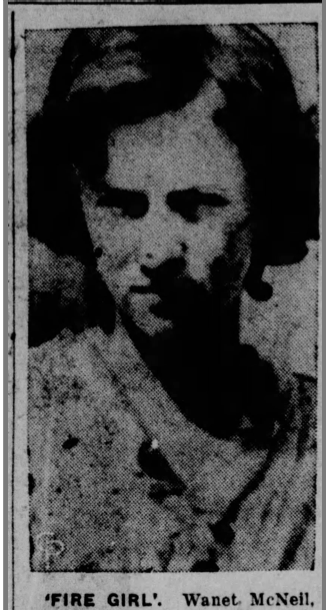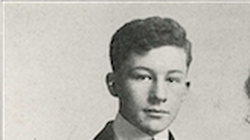 Bath from his high school yearbook.
Bath from his high school yearbook. Gomer David Bath was born 22 February 1899 to David Bath and the former Julia Sullionec in Illinois. Both of his parents had also been born in Illinois, as well, his father’s family coming from the United Kingdrom, his mother’s from Ohio and New York. He was the second son. His father was working as a baker. By 1910, David was at an insurance agency and his older brother Lee worked on a variety show; the family, like Thayer’s—also from Illinois, Thayer born just a few years later—was artistically inclined, with David serving as director of his church’s choir for twenty years. The family was enlarged by two daughters, Ruby (b. 1902) and Helen (b. 1912). Gomer went to Canton High School, where he was on the debate team, a musical director for the school theater, and president of the Athletic, Literary and Musical Association. He graduated in 1917 and, with a scholarship, went to Lake Forest College. Gomer was a private in the Students Army Training Corps during the Great War.
Judging by census records, the family situation was economically difficult as of 1920. In addition to the three kids—Lee, the older brother, had moved out—there was David, and Julia, Julia’s mother. The family was renting their home. Neither of the parents, nor the grandparent, was working—only Ruby, who was a teacher, and Gomer, who was a traveling musical salesman. (Not Harold Hill, surely!) Apparently his work took him at least to Paducah, Kentucky, because that’s where his high school’s alumni committee found him in 1920. Bath supposedly also attended Know College before graduating from the University of Illinois in 1922. By 1930, he was married with two children, Robert and Mary (ages 6 and 1, putting his marriage shortly after his graduation). Gomer was working as an organist for a theater.
The late 1930s were a trying time for Bath. His mother died in 1936, and his father moved in with Helen, the youngest daughter. In 1939, Homer’s wife died, from accidental poisoning. The following year, David—his father—died. The 1940 census, though, does have him remarried, to a woman named Dorothy, who was either twelve or twenty-one years his junior. (It’s hard to say if her age was 29 or 20; Gomer was 41.) I don’t know anything about her, though.The city directories had them together as later as 1959.
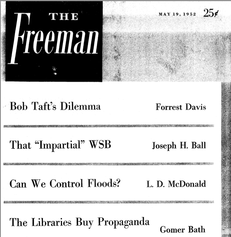
Bath was a Republican, and involved with Republican politics. He was also a crusader, notably in the late 1940s and early 1950s. In 1947, he lobbied against the singer Paul Robeson’s coming to Peoria because of Robeson’s communist connections. In the early 1950s, he attacked the University of Illinois for the books and filmstrips purchased by the library—they were propaganda, too. And in 1953 he attacked the press—the AP and UP—for its whitewashing coverage of G. Bromley Oxnam’s appearance before the House Un-American Activities Committee. The wire services had declared that Bromley was cleared of being a red stooge—but his very testimony proved he had been, joining communist organizations, lending his name to them, even though he didn’t really know what they were doing. Those journalists, he said, “could not tell the story straight.”
Bath suffered a fatal heart attack in his car on 16 March 1960. He was sixty-one.
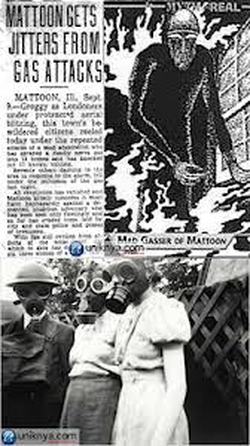
In late August 1944, residents of Mattoon began complaining that they smelled a sweet gas that left them feeling nauseous and partially paralyzed for about a half hour. News spread through the community—carried by the Mattoon Journal-Gazette—and more reports came in, unevenly distributed across the city. The police became involved, and even the FBI had an interest. Soon reports of the gassing intersected with reports of a tall, black-clad stranger. Some presumed he was the mad gasser. Maybe he was a crazed scientist. Or a Nazi. Maybe the gas was caused by an ape-man, even. By the middle of the month, the reports of gassings dried up, and city officials—including, now, the newspaper—chalked it all up to fantasy.
Donald Johnson, a professor at the University of Illinois, investigated the story, interviewing witnesses, reviewing police records. He said the Mad Gasser was a perfect example of mass hysteria. Notably, over 90% of the victims were women, and were undereducated. To a male professor, that was an indication of their inability to critically reason—and their susceptibility to emotional overreaction. Johnson published an academic paper on the events the following year, establishing Mattoon as a classic case and setting the terms of debate for the next seventy years: on one side are those who say nothing more extraordinary happened in Illinois during those few weeks than a bunch of people losing their heads and becoming overly scared about the War; on the other side are those who acknowledge that something happened, even as they disagree about exactly what, and who the culprit was: a diesel factory in town, an extraterrestrial, a scorned chemical genius, etc., etc.
The story, understandably, caught the attention of Forteans, and was one of four featured tales in Doubt 11 (winter 1944). Thayer wrote:
“The Mattoon business began on the last day of the month of Fort (that is September 2nd, old style), when a ‘tall, thin man n a skull cap’ is alleged to have sprayed a mother and child with ‘heavenly but sickening’ (redundant?) gas. If the sprayer was a visitor from one of Fort’s New Lanbds, who arrived in a fiery chariot about two weeks before, he is going to have a hard time getting spare parts for the return journey. The Society’s expert on celestial visitors has not peeped on this subject. We more than half suspect that he had a rendezvous with this interplanetary Hess.When 14, 24 and finally 40 or more Mattoon matrons had been ‘gassed,’ Orthodoxy smothered the inexplicable with the ever handy blanket of ‘mass hystweria’. See Chapter 3 of Wild Talents, p. 850 ff., in the Books of Charles Fort.”
Thayer’s response betrayed a disbelief in the story, a disdain for town officials, and a distaste for his own Forteans. Plus there was the matter of the wrong date. The events started at the end of August, not the beginning of September. But that hardly mattered for the joke Thayer was trying to tell: one of the other four big stories in that issue of Doubt was an object streaking across the Midwestern sky in the middle of August—including on the 13th day of his invented month, Fort. So he was suggesting that the Gasser may have been responsible for that light show, too. He mockingly said he was afraid to way in, though, because he hadn’t heard from Frederick Hehr—he was the Society’s expert on celestial visitors, having claimed to have been in communication with Venusians—and Thayer was poking fun at him suggesting he was meeting the interplanetary Hess—Hess being the oil company.
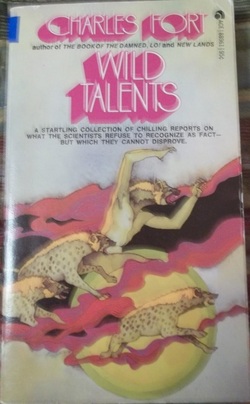
But “the best part of these phenomena” Thayer said, “was the discovery of Gomer Bath, a Fortean of high caliber writing a column for a Peoria paper.” Bath sent Thayer daily reports on the investigation. Likely, Thayer had come across one of Bath’s columns and wrote him a letter—a correspondence then developing, with Bath eventually becoming a member: by the winter of the following year, Thayer listed him as an MFS.
And there’s every reason to believe that Bath was interested in Fort. He contributed clippings to Thayer over the years, on flying saucers (Doubt 19); a man-beast in Indiana (Doubt 20); and a water-filled barrel that never needed replenishment (Doubt 31). He peppered some of his articles with references to Fort—likely this was Thayer’s influence, Thayer probably introducing Bath to Fort. It is also likely that Thayer had Bath look to see if there were copies of Fort’s books in local libraries. At any rate, whether asked or of his own initiative, Bath reported to Thayer that Fort’s books were not widely available in the small libraries where he lived—and that got Thayer crusading, telling his readers to check their libraries and get them to order the book if they didn’t have it on the shelf.
Throughout his time publishing Doubt, Tiffany Thayer was constantly on the look-out for what he called an honest daily newspaper. He had members point him to one, and then he would subscribe for a time. Nothing every fully satisfied him, but he did come close a couple of times, with the Liverpool Daily Echo, the Christian Science Monitor (much to his surprise), and Bath’s columns. Thayer saw, in Bath, the same animating spirit that had moved the founders of the Fortean Society. He wrote in Doubt 13 (Winter 1945, 191):
“Gomer Moves Athens:
“When Ring Lardner, Sherwood Anderson, Theodore Dreiser, Ben Hecht, Carl Sandburg, Keith Preston, Bert Leston Taylor, Harry Hansen, Samuel Putnam, Edwin Balmer, and Your (unpublished) Secretary, ae 18, were all residents of Cook County simultaneously, some eastern wag dubbed Chicago ‘the Athens of the Middle West’. At that time, Peoria was known as the former residence of Bob Ingersoll, the home of some pretty fair whisky, and a never-failing laugh in Vaudeville. But now that the only author left between Cicero and the Lake is Marshall Field, Peoria is coming into its own.
“MFS Gomer Bath conducts a column down there, always sprightly, and always as sensible as a daily’s traffic will permit. He’s the gadfly of the mentally slothful, and as frequently as he thinks he can get away with it, he comes out flatfooted in favor of the gentle art of thinking. As a result, the Society boasts more members in Peoria than in any other city of like size in the world.”
I have no idea if Thayer’s last claim is true—to this point, I haven’t uncovered any Fortean Society members living in Peoria besides Bath. But perhaps I will yet.

“Laughing Charles Fort
“‘Progress,’ said Benjamin de Casseres, ‘is nothing but the victory of laughter over dogma.’
“The most civilized erudite and literate laugher at dogma of the present generation was Charles Fort. It should follow, therefore, that the disciples of modern progress hail Charles Fort as their prophet. But I seldom meet a person who responds with any sign of recognition at the mention of the name Fort.
“There may be several reasons for the relative obscurity of this great American thinker, including the fact that he did not seek popular acclaim. One of those reasons, I think, is the failure of Forteans to proclaim Fort’s delightful and malicious sense of humor. I know of no writer of this century who has so joyfully amused himself at the expense of dogmatic wiseacres as Charles Fort. This poking fun at dignity in high places he does with such finesse that a discriminating sense of humor is needed for full appreciation of it. But his delicate laughter is enduring. The reader who finds Fort in “The Book of the Damned” or any of his other three major works, may be sure that he has discovered a lifetime retreat from the wearying dignity of stuffed shirts. Reading a few pages of Fort almost at random will restore one’s good humor as surely as a cloth restores the polish of a waxed surface.
“One may read logical presentations of, attacks against and defenses of any idea ever known to mankind and find the scales well balanced on controversial questions of the ages. Such is the power of logic that it may defend a false position as ably as attack it. But against the power of laughter there is no defense.
“It is perhaps a god thing that the gift of humor is not widespread. ‘Humor is a divine attribute,” said George Bernard Shaw. Upon but a few is the great gift bestowed. If many possessed it, what we know as order in the world would vanish.
“‘The Book of the Damned’ is about countless things that have happened, things that people have seen, felt and heard, things that have been recorded in newspapers, things that have excited cities and nations (remember the unexplained ‘flying disks’ of the summer of 1947?) but have nevertheless been declared not to have happened. Why? Because they could not be explained by any principles accepted by orthodox science.
“‘A procession of the damned,’ Charles Fort calls these things. “By the damned, I mean the excluded. We shall have a procession of data that Science has excluded.”
“And what a procession it is! In the four books (the other three are ‘New Lands,’ ‘Lo!,’ and ‘Wild Talents’) there are 1,062 pages of these unexplained happenings, the data ‘damned’ by science because it would not fit into any of the theories which scientists currently agree are true.
“Science’s ‘seeming approximation to consistency, stability, system--positiveness or realness--is sustained by damning the irreconcilable or the unassimilable,’ says Fort. ‘All would be well. All would be heavenly--if the damned would only stay damned.’
“So Fort spent his life digging up thousands of facts that had not and could not be explained, and writing them with great gusto, poking fun all the while at dogmatic theorists who turned their backs on these facts rather than admit that unexplainable mysteries existed.
“Fort’s books are not attacks on science. They attack the dogmas of science which are held to be final and absolute truths. And in so attacking, Fort proved himself more the true scientist than many scientific bigwigs who scorned him and his work. ‘Certitude is not the test of certainty,’ said Justice Oliver Wendell Holmes, himself a Fortean. We have been cocksure of many things that were not so.’
“And so Charles Fort laughed at dogma and his quiet laughter will echo through the years. And if more people knew of his great sense of humor, the books of Charles Fort would be more widely read than they are.”
Bath, like Thayer, thought that journalism was conducted by unthinking ideologues. And so both found Fort thumbing his nose at them—and other officials—funny. It’s just that Bath and Thayer had different ideas about the power to whom truth was being spoken. Thayer, never a leftist, had progressive sympathies, and found businessmen, scientists, and stodgy politicians objects of ridicule. (For what it's worth, George Seldes also disapproved of Bath.) Bath, much more conservative, thought disdain—in the form of laughter and censorship—should be directed at those he saw as un-American. Given this stark political difference, the surprise isn’t that Bath—like so many other Forteans of the forties—separated from the Society at the beginning of the 1950s. The surprise is that he stayed connected for so long. Probably it’s not a coincidence that issue 30—the issue before Bath last appeared in Doubt—featured on its cover the giant headline “Peace is a Red Plot.” This issue came out as Bath was working with the American Legion to keep so-called Communist propaganda out of public libraries. Red Plots, for him, were real. And serious.
Nonetheless, before his exit, even before his column extolling the many virtues of Charles Fort, Bath had a chance to be involved in one of the signal Fortean episodes of the 1940s, one that captured so much of Thayer’s approach. Four years after the events at Sugar Plum school in North Dakota, came another tale of wild talents, botched journalism—and dangerous girls. If Forteans were interested in anomalies and the unacknowledged—and they were—then that necessarily meant they’d be interested in women and girls, who so often went unremarked, except when needed to close a controversy.
Red-headed, of course, but slight—unnoticed. That was Wanet.
She was born in 1935. There were probably good times. There were definitely bad times. A brother was born, World War II started—and her parents divorced. Wanet’s mother, Leona, married Lloyd Eagle and moved into trailer in Bloomington, Illinois. There wasn’t enough room for the children. Wanet and Arthur, Jr., they went with their father—moved in with his sister and her husband, on a farm near Macomb.
Now the Willeys, they were older, married late, never had children. He was tall, she was short and squat. Lulu had been 25 when Arthur was born, almost 40 when she married Charlie. But the Willeys and the McNeils were close enough. Back in 1940, another of her brothers, Bert, had worked on the farm, too. Didn’t get paid, but got a place to sleep. That brother was just a few years older than Arthur.
The Willeys had a good sized farm, by accounts. Six buildings, including a house, barn, and chicken coop. They had livestock. Charley’d been working it his whole life, taking over even when his mom and dad were still alive, still living there. He’d quit school in third grade, Lula in fifth. Already, Wanet, in sixth grade, had more education than either of them. And she did not want to be there, on that farm. She wanted to be with her mother. Charley and Lula, she would say, they didn’t let her buy any pretty clothes.
Middle of August, it’s hot and humid in Illinois. Sometimes the skylights up with fireworks. Sometimes, the houses do, too. But not like this. One hundred, two hundred fires. They’d start in the wallpaper, spread. Start in cabinets. Curtains ignited. The five-room cottage that was home to the pair of Willeys and trio of Mcneils burned down on a Saturday. The family moved to a garage. Garage burned down, and they moved to a tent, taking supper in the milk house, where they hung paper against the blowing wind. Even as they sat in that small dining area, fires would start on the wall. Sitting outside the tent one day, Charley and Lula saw their second barn burn. Only took 26 minutes. Firemen arrived after it was only a charred skeleton.
Newspapers took notice—moths to a flame, not thinking they could get burned. Not noticing that red-haired girl. They talked about smoldering brown spots in the wallpaper, the way flames leapt out wen the paper was pulled down. Macomb fire chief told the newspapers he was ‘completely mystified.’ State Deputy Fire Marshal tried a trick: tacked newspapers to the smokehouse, waited to see if they’d burst into flames. Crowds gathered. The newspapers survived, that time.
What could it be?, they all wondered. Old Charley, he was honest, said he didn’t have an enemy in the world. Sure, he had insurance, but only $1,800, far less than what the place was worth on any rightful reckoning. Papers liked the word ghostly, liked the word phantom. Others thinking more scientific. The fly spray they used to beat back the pests was highly flammable. Maybe it saturated the walls, made them vulnerable. Could be radioactivity, that’s what Lewis C. Gust, Office of Technical Progress, at Wright Field, said. Maybe it was sabotage, he said. “Suppose you had material that could be ignored by radio and you wanted to test it for sabotage value. Wouldn’t you pick some out-of-the-way place, like the Willey farm, to make the test.” But it’s never the government guy who’s accused of hysteria.
Cherhcez la Wonet.
The Willeys and the McNeils, they left that home where Charley had lived his long life, moved into a vacant house nearby. Crowds gathered round there old place, hoping to see sparks fly. But none ever did, not anymore, not at that place. Fire Marshal said there were too many people. Said he theories had gotten out of hand. Scientists had studied the wallpaper, found nothing unusual, looked for gas in the ground, found none. He thought it was a firebug—but Charley Willey said couldn’t have been: he’d have seen an arsonist. (Those Mattoon matrons had seen the gasser, hadn’t they?, he could’ve asked, but didn’t.) The chickens and the calves, they were left behind.
And then Lulu was canning tomatoes on a Saturday. And she found the shelf paper in the kitchen cupboard ablaze. More and more fires at the new place, so hard to keep track of, the family wasn’t sure how many. Newspapers didn’t know what to report about the Willeys—he was scared and not going back, some said; no, he wouldn’t be bullied and planned to rebuild nodded others. Fire Marshall John Craig said he’d use the lie detector to ferret out the culprit.
But that didn’t scare the fire marshal “The fires were set by an arsonist,” Craig said. “We know who set them, and are trying to get evidence that will stand up on court.” Charley, he took the lie detector, so did Arthur and Arthur Jr. But Lulu refused. And so did the Willey’s niece, finally noticed, Wanet McNeil.
Cerchez La Wanet.
They’d cracked the case, the fire marshalls said. The man doing the investigating for Craig told the press officials had solved the mystery of why fires “shot out of walls like lighted gas out of a blow torch.” He said “The fires were set by an arsonist. We know who he is and we’re trying to get evidence that will stand up in court.” He told reporters that the arsonist had refused a lie detector test. He also said that the arsonist was “not any member of the Willy’s family.”
Ain’t that the way it goes? Not mentioned, not noticed—she becomes a he, and doesn’t even count as family. Not even sure of her name: Juanette McNeal—Juanett McNeil—Wanet McNeil—Janet McNeil—Wonet McNeil—Wonet Ethyl McNeil. Name didn’t really matter: just that the case had been solved. And it was an unruly girl responsible. (Just like at Sugar Plum school, someone could have said, but didn’t). Maybe she was 12, maybe she was 13. (Her birthday was 30 August, just as the case ended: happy birthday, whatever your name is!) But they got the color of her right. If it was reported, it was always reported as red.
The papers didn’t know it: but they were burning themselves. Wanet said she’d started the fires when no one was looking, touching matches to the wall, because she hoped to get back to her mother. A psychiatrist in Chicago examined Wanet and declared her fully normal—just hurt by her parents divorce. And that was the message: divorce, it’s bad on the kids. No one pressed charges. The Willeys—they didn’t press charges. “She’s just a child. We don’t really know why she did it, but we don’t blame her.” But the solution proved inadequate to the mystery: too many details were left unexplained, the spreading brown spots, the fires started when someone else was in the room, the arsonist who was a man and wasn’t part of the family, the carefully built case that never went to court. Accept the solution, sure, but then question the initial reporting. Can’t have it both ways.
And after the solution? Wanet slipped away again, unnoticed, mostly. She went to live with her maternal grandmother, nearer her mom. She couldn’t live with her dad anymore, because the farm’d been burned down, said the papers—but apparently the younger Arthur, being smaller, could?—and her mom’s trailer was too cramped for a thirteen year-old girl. But look what you see, when you Cerchez La Wanet? There, in the City directory from 1953. Living on Rd. 6 in Bloomington. There’s Lloyd and Leona Eagle. And, on another page, under M, there’s Wanet McNeil. She got to be with her mom after all.
Cherchez La Wanet.
Thayer had great fun undressing the press and then revealing the newspapers’s sad reliance on tropes—tropes which Fort himself had identified, the adolescent girl with wild talents one of his discoveries:
“We Break Down,” [Doubt 23, Dec. 1948, 348-9]:
“Never--or hardly ever--have we thought that a Fortean Law could be formulated on any subject, but that just shows how little we were prepared for Macomb, Illinois, and its fires. After a thorough study of the data, we give you Fort’s Law for Explaining Mysterious Fires. It is Cherchez la Wonet.
“That is to say that no matter what the real circumstances (which nobody ever knows) and no matter what fictional circumstances the wypers invent (which is all you or I ever have to go by), sooner or later an adolescent female will be found or invented to ‘confess’ or to ‘be accused of’ or to ‘explain’ the otherwise inexplicable. That is Wonet.
“The wypers build the fires, and the wypers put them out. Blessed be the Name of the Wypers.
“In the Macomb case, the hysterical rewrite men--probably a hundred miles from the farm--larded their original tale with so much bafflement that not even miracles or magic could have got them out of it. So that even when they spring Wonet nobody believed them.
“YS recommends that the so-called journalists who concocted this mystery read S. S. van Dyne’s rules for writing whodunits. One cardinal principle of the craft is that no new character shall walk into the plot near the finish and shoulder the blame. The guilty party has to be on the scene at the time the crime is committed or the story isn’t kosher.
“Well, our coverage of the Macomb yarn is complete--to say the least--and Wonet is not mentioned until she turns up, a scapegoat, complete with horns and rue.
“Photographs of the family made early in the case show two young children of Arthur McNeil, a boy named ‘Art’ and a girl labeled ‘Ethel.’ No Wonet. And neither does ‘Ethel’ of the family group resemble the solo photos of ‘Wonet’ printed later. Neither does any wyper say that Wonet used to be called ‘Ethel’ or that she has such a middle name. In fact, the people who ‘solved’ the mystery show no more consideration for the previously published details which want fitting than a banker feels for a ‘gold-star’ mother.
“Especially fine work was done for the Society throughout the case by MFS Gomer Bath, columnist, who called Fort to witness every day for his readers, and //349//who scoffs the alleged confession of Wonet, Wanet, uanet, as fantastically impossible. We agree with Brother Gomer. But--the next time your wall paper bursts into flames--remember Fort’s Law: Cherchez la Wonet.”
Thayer, for all that he insisted he had a complete file, didn’t get the facts completely straight himself. Wanet did make an appearance just before she was blamed. And at least one report did have her middle name as Ethyl. I haven’t seen any pictures of either children from before the accusations were made to know if they resemble the many pictures that were spread of Wanet after she confessed to her crime.
Clearly, there’s sociological dimensions to the story that the writers don’t even consider. Could Wanet have admitted to the fires, even if she had not started them, so that she could get sent away from the farm, and maybe to her family? That certainly seems possible. And that explanation doesn’t trip over the fact that the reader is meant to believe that a 12 year old girl started over 200 fires without her family ever noticing once. Nor the apparent ease with which she could start the fires. The stories do not make sense of the officials’s contradictory statements, nor Lulu’s refusal to take a polygraph test.
So much is missed—which is exactly why Thayer thought the event was of Fortean importance even if no strictly Fortean phenomena happened. Watching the newspapers work—the term wiper he borrowed from Ezra Pound—was a case study in seeing how certain facts—or reported facts—were damned.
And there’s a PS: I took Thayer’s advice, and I cherchezed la Wanet. She’s tough to track down, appearing in few official documents. Most of the family details come from the new stories, and those clearly are not terribly reliable. But Wanet is an unusual enough name I could do some fishing—and found a Wanet R. Beier, born 30 August 1935, living in Bloomington, Illinois, from 1992 to 1994. Has to be her, right? A bit more digging, and there’s an obituary—and it is. From the Bloomington Pantagraph, 26 June 2006:
MINIER — Wanet E. "Micki" Beier Romans, 70, Minier, died at 11:40 a.m. Sunday (June 25, 2006) at OSF Saint Francis Medical Center in Peoria.
She was born Aug. 30, 1935, in Macomb, to Arthur and Leona Johnson McNeal. She married Dale Romans on April 5, 1994, in Prescott, Ariz. He survives.
Also surviving are two sons, Daniel (Julie) Bustle and Gary (Donna) Beier, both of Normal; two daughters, Debbie Phipps and Kim (Jeff) Cagley, both of Bloomington; 11 grandchildren; one great-grandson; and two brothers, Bob McNeal, California, and Jay Eagle, Bloomington.
She was preceded in death by her parents.
She enjoyed the years she lived in Tennessee, traveling, cooking and shopping. She will be sadly missed by her family and friends.
Wanet attended the Assembly of God Church, 604 S. Minier Ave., Minier, where a memorial service will be at 7 p.m. Thursday. Pastor Guy Caley will officiate. Visitation will be from 4 to 7 p.m. Thursday at the church.
In lieu of flowers, the family requests that donations be made to Assembly of God Church, Minier.
So sometime after 1953, when she was a saleswoman living next to her mother and father, she married someone with the last name Beier. Turns out his first name—based on the marriage announcement of their daughter Debbie—was Russell. He had been born in 1927 and served during World War II, according to his obituary (The Pantagraph 5 Nov. 2008). Joys came to them. They had two sons and two daughters, in-laws, and grandchildren.
She had troubles, too. In 1983, she was admitted to the hospital with breathing troubles. That year, too, the Beiers sold their house. And there was a divorce. In 1983, the same year he would be married, Gary Beier, a son, was arrested for forging a traveler’s check. In 1989, she was caught forging checks. At the time, she was subbing as a caretaker for an invalid, and had the woman make out a blank check to Eagle—the name of a grocery store. Rather than buy groceries, Wanet changed the check to the name of someone else named Eagle—recall, her mother had married in to a family by that name—and cashed them for more than $9,800, more than $7,000 of which went to buy a car. She also tried to forge her paycheck by writing a 2 in front of the $500 amount, but that charge was dropped in exchange for her guilty plea. With no prior convictions, she faced up to two years in prison.
She married again on 5 April 1994, at the age of fifty-nine, in Arizona, where she lived for a time. Her husband was Clarron Dale Romans, and he was sixty-three. He had been born in Illinois, like her, and served in the military in the early 1950s, where he attended jet mechanic school. They moved toTennessee before ending up back in Illinois. Interestingly, her brothers name is given here as Bob. One news report in 1948 did call him Robert McNeal, but all the others referred to him as Arthur, Jr.: another detail garbled.
But there’s also one more bit—eery, Fortean. Here’s the story, from the Bloomington Pantagraph, 30 March 1979, page 35. At the time, Micki and Russ were living in Normal—the town name only putting to fine a point on the ballad’s conclusion:
“Normal Home Damaged by Mattress Fire
Normal Firemen Thursday night were called to a mattress fire in the basement of the Micki and Russell Beier house at 601 S. Linden St. Normal.
“Mrs. Beier said her husband was alone at home when she arrived at the residence to find smoke pouring out of the basement and kitchen.
“‘The kids and I left to get some school supplies,’ she said. ‘We pulled into the driveways and saw smoke coming out of the basement.’ She said that could see smoke coming from the side door of the two-story home by way of the basement and kitchen.
Normal fire Capt. John McAtee said the fire was in the mattress. Firemen Friday said they suspected smoking materials had been used carelessly.
McAtee estimated damage at $2,000 to the contents of the house, which received smoke damage though out. He said there was no structural damage."
